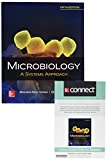
GEN COMBO LOOSELEAF MICROBIOLOGY:A SYSTEMS APPROACH; CONNECT ACCESS CARD
5th Edition
ISBN: 9781260149364
Author: Marjorie Kelly Cowan Professor
Publisher: McGraw-Hill Education
expand_more
expand_more
format_list_bulleted
Question
Chapter 20.3, Problem 13AYP
Summary Introduction
To discuss:
The epidemiology of HIV infection in the developed and developing world.
Concept introduction:
HIV belongs to the retroviruses family, all of which contains the RNA genome. The virus attaches and penetrates T cells of the human that play an essential role in the immunity of a person. Infected cells express the viral genes and produce new viruses which in turn infect other T cells leading to a decrease in the population of T cells. Eventually, loss of T cells results in a decline in the immune system of the body for other diseases as well.
Expert Solution & Answer
Want to see the full answer?
Check out a sample textbook solution
Students have asked these similar questions
The Sentinel Cell: Nature’s Answer to Cancer?
Molecular Biology Question
You are working to characterize a novel protein in mice. Analysis shows that high levels of the primary transcript that codes for this protein are found in tissue from the brain, muscle, liver, and pancreas. However, an antibody that recognizes the C-terminal portion of the protein indicates that the protein is present in brain, muscle, and liver, but not in the pancreas. What is the most likely explanation for this result?
Molecular Biology
Explain/discuss how “slow stop” and “quick/fast stop” mutants wereused to identify different protein involved in DNA replication in E. coli.
Chapter 20 Solutions
GEN COMBO LOOSELEAF MICROBIOLOGY:A SYSTEMS APPROACH; CONNECT ACCESS CARD
Ch. 20.1 - Describe the important anatomical features of the...Ch. 20.1 - List the natural defenses present in the...Ch. 20.2 - Prob. 3AYPCh. 20.3 - Prob. 4AYPCh. 20.3 - Prob. 5AYPCh. 20.3 - Prob. 6AYPCh. 20.3 - Prob. 7AYPCh. 20.3 - Prob. 8AYPCh. 20.3 - Prob. 9AYPCh. 20.3 - Identify the five or six most relevant facts about...
Ch. 20.3 - Prob. 11AYPCh. 20.3 - Prob. 12AYPCh. 20.3 - Prob. 13AYPCh. 20 - Prob. 1MCQCh. 20 - Prob. 2MCQCh. 20 - Prob. 3MCQCh. 20 - Rabbit fever is caused by a. Yersinia pestis. b....Ch. 20 - Prob. 5MCQCh. 20 - Prob. 6MCQCh. 20 - Prob. 7MCQCh. 20 - Prob. 8MCQCh. 20 - Prob. 9MCQCh. 20 - Prob. 10MCQCh. 20 - Brucellosis can be transmitted to humans by...Ch. 20 - Prob. 12TFCh. 20 - Prob. 13TFCh. 20 - Prob. 14TFCh. 20 - Prob. 15TFCh. 20 - Explain why cases of dengue fever have been...Ch. 20 - Prob. 2CTQCh. 20 - Prob. 3CTQCh. 20 - Prob. 4CTQCh. 20 - Prob. 5CTQCh. 20 - Prob. 1VCCh. 20 - Prob. 1CM
Knowledge Booster
Similar questions
- Molecular Biology Question A gene that codes for a protein was removed from a eukaryotic cell and inserted into a prokaryotic cell. Although the gene was successfully transcribed and translated, it produced a different protein than it produced in the eukaryotic cell. What is the most likely explanation?arrow_forwardMolecular Biology LIST three characteristics of origins of replicationarrow_forwardMolecular Biology Question Please help. Thank you For E coli DNA polymerase III, give the structure and function of the b-clamp sub-complex. Describe how the structure of this sub-complex is important for it’s function.arrow_forward
- Molecular Biology LIST three characteristics of DNA Polymerasesarrow_forwardMolecular Biology RNA polymerase core enzyme structure contains what subunits? To form holo enzyme, sigma factor is added to core. What is the name of the structure formed? Give the detailed structure of sigma factor and the function of eachdomain. Please help. Thank youarrow_forwardMolecular Biology You have a single bacterial cell whose DNA is labelled with radioactiveC14. After 5 rounds of cell division, how may cells will contain radioactive DNA? Please help. Thank youarrow_forward
- 1. Explain the structure and properties of atoms and chemical bonds (especially how they relate to DNA and proteins). Also add some pictures.arrow_forward1. In the Sentinel Cell DNA integrity is preserved through nanoscopic helicase-coordinated repair, while lipids in the membrane are fortified to resist environmental mutagens. also provide pictures for this question.arrow_forwardExplain the structure and properties of atoms and chemical bonds (especially how they relate to DNA and proteins). Also add some pictures.arrow_forward
- In the Sentinel Cell DNA integrity is preserved through nanoscopic helicase-coordinated repair, while lipids in the membrane are fortified to resist environmental mutagens. also provide pictures for this question.arrow_forward1. Explain how genetic information is stored, copied, transferred, and expressed. Also add some pictures for this question.arrow_forward!. Describe biological macromolecules (DNA, RNA, proteins, lipids, etc.) and how they function in the cell. also provide some images for this question.arrow_forward
arrow_back_ios
SEE MORE QUESTIONS
arrow_forward_ios
Recommended textbooks for you
 Comprehensive Medical Assisting: Administrative a...NursingISBN:9781305964792Author:Wilburta Q. Lindh, Carol D. Tamparo, Barbara M. Dahl, Julie Morris, Cindy CorreaPublisher:Cengage LearningHealth Safety And Nutrition F/Young ChildHealth & NutritionISBN:9781305144767Author:MAROTZPublisher:Cengage
Comprehensive Medical Assisting: Administrative a...NursingISBN:9781305964792Author:Wilburta Q. Lindh, Carol D. Tamparo, Barbara M. Dahl, Julie Morris, Cindy CorreaPublisher:Cengage LearningHealth Safety And Nutrition F/Young ChildHealth & NutritionISBN:9781305144767Author:MAROTZPublisher:Cengage- Lifetime Physical Fitness & WellnessHealth & NutritionISBN:9781337677509Author:HOEGERPublisher:Cengage


Comprehensive Medical Assisting: Administrative a...
Nursing
ISBN:9781305964792
Author:Wilburta Q. Lindh, Carol D. Tamparo, Barbara M. Dahl, Julie Morris, Cindy Correa
Publisher:Cengage Learning

Health Safety And Nutrition F/Young Child
Health & Nutrition
ISBN:9781305144767
Author:MAROTZ
Publisher:Cengage

Lifetime Physical Fitness & Wellness
Health & Nutrition
ISBN:9781337677509
Author:HOEGER
Publisher:Cengage

